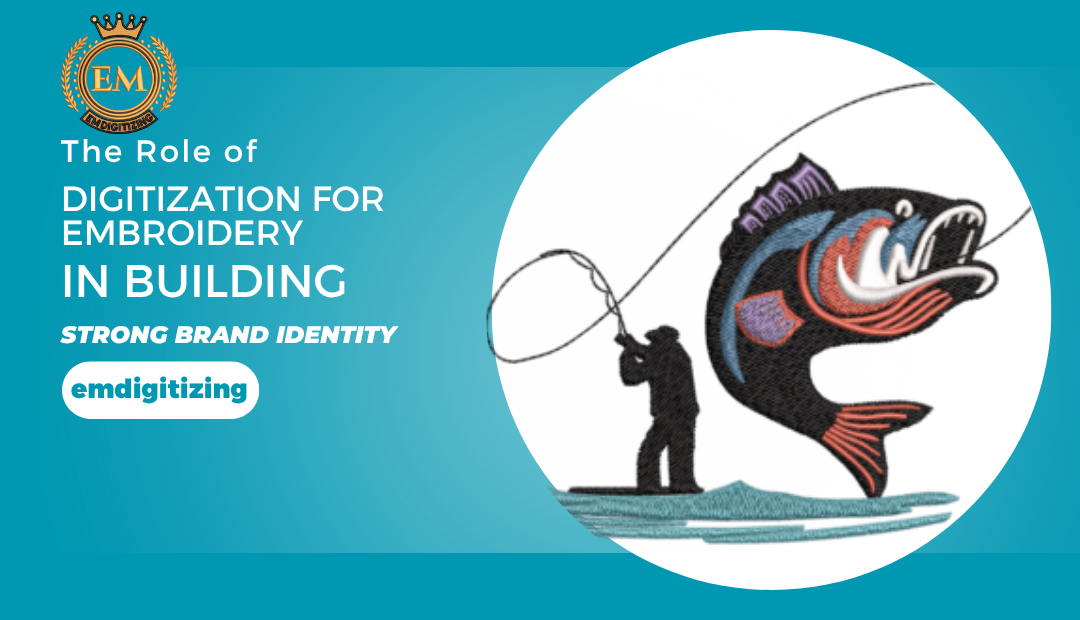In a competitive global marketplace, brand identity is more than just a logo—it’s the visual and emotional representation of a company’s values, story, and promise to its audience. For businesses aiming to create a memorable brand presence, embroidery offers a tangible and lasting way to showcase their logo and visuals on uniforms, merchandise, and promotional products. At the core of this branding strategy lies an essential yet often overlooked process: digitization for embroidery.
This blog explores how digitization for embroidery plays a vital role in building brand identity. From design accuracy to consistency in mass production, this digital bridge between art and stitching helps brands project a cohesive and professional image.
What Is Digitization for Embroidery?
Before diving into its branding benefits, let’s clarify what digitization for embroidery means. Digitization is the process of converting artwork, logos, or images into a machine-readable file format that guides embroidery machines in stitching the design.
This specialized process translates each component of a design—lines, curves, fill patterns, stitch density—into a sequence of commands. A properly digitized file ensures that the embroidery machine reproduces the design with high fidelity, regardless of fabric type or garment style.
Why Brand Identity Needs Consistency
Brand identity thrives on consistency. From business cards to employee uniforms and retail packaging, every visual element must align with the overall brand message. Embroidered logos are especially powerful because they’re often used in:
- Corporate uniforms
- Promotional giveaways
- Branded merchandise
- Staff accessories (hats, bags, aprons)
- Trade show displays
A poorly digitized logo can result in distorted stitches, uneven color fills, or inaccurate dimensions, which weakens the brand image. That’s why high-quality digitization for embroidery is essential for businesses that care about consistency and professionalism.
Benefits of Digitization for Embroidery in Branding
1. Accuracy and Detail Preservation
Your brand’s logo is a symbol of your identity. Any deviation from its intended design can confuse or mislead customers. Professional digitization ensures:
- Sharp, clean outlines
- Accurate color transitions
- Consistent stitch lengths
- Proper scaling across product sizes
This high level of design accuracy allows businesses to replicate their branding across a wide variety of embroidered products without compromising on visual fidelity.
2. Fabric-Specific Adaptation
Different fabrics behave differently under embroidery machines. What works for a cotton polo shirt might not be suitable for a nylon jacket or a stretchable sportswear item.
Expert digitizers understand these nuances and adapt stitch types, tension, and density based on fabric characteristics. This results in a consistent visual appearance of the logo regardless of fabric type—a key element of maintaining cohesive brand identity across apparel.
3. Scalability Across Production Volumes
Whether you need 10 pieces or 10,000, digitized embroidery designs can be used at scale without sacrificing quality. This scalability helps brands maintain consistent logos and messaging across uniforms, giveaways, and mass-produced products.
Large enterprises, franchises, and event organizers rely on this capability to ensure their branding remains intact, even when produced across different regions or facilities.
4. Customization and Seasonal Branding
Digitization makes it easy to modify existing designs for different campaigns, events, or seasons. Want to add a winter motif or holiday element to your logo without compromising its core structure? It’s possible through minor edits in the digitized file.
This flexibility allows brands to stay visually relevant while maintaining core identity—a crucial strategy for engaging modern consumers who expect personalization and novelty.
5. Cost Efficiency in the Long Term
While professional digitization may have an upfront cost, it pays off in long-term savings. A high-quality embroidery file reduces thread breaks, production time, and material wastage. More importantly, it avoids costly re-runs due to flawed designs.
The ROI comes from better production efficiency, reduced errors, and strong, consistent brand impressions over time.
How Different Industries Use Digitized Embroidery for Branding
Corporate Sector
Companies use embroidered uniforms to create a professional, trustworthy look for employees. Whether it’s hospitality, retail, or logistics—embroidered logos on shirts, caps, or jackets signal reliability and unity.
Hospitality & Tourism
Hotels, airlines, and travel agencies use digitized embroidery for staff uniforms, luggage tags, and merchandise. The consistency of embroidered branding helps reinforce premium service and brand prestige.
Healthcare and Wellness
Medical uniforms, spa robes, and scrubs often feature embroidered branding. In these industries, clean and precise branding reflects hygiene, care, and credibility.
Sports & Fitness
Team jerseys, workout apparel, and promotional gear rely heavily on embroidery. Digitization ensures that logos remain sharp and visible, even under stress and repeated washing.
Fashion and Lifestyle Brands
Boutique fashion labels often use embroidery to add texture and depth to their branding. From limited-edition patches to logo details on denim and outerwear, digitization allows artistic freedom while retaining control.
Branding Touchpoints Enhanced by Embroidery
- Employee Uniforms
Branded uniforms create a cohesive look and foster a sense of team spirit. Digitized logos ensure that every piece looks exactly as intended, regardless of the garment. - Promotional Products
Branded items like tote bags, caps, and accessories become walking advertisements. Digitized embroidery ensures these items look premium and polished. - Retail Product Labels
Embroidered labels add a premium touch to high-end products like leather goods, denim, or handmade accessories. - Event Merchandise
Trade shows, expos, and brand events often feature limited-run embroidered products. Digitization ensures fast turnaround with reliable quality. - Customer Loyalty Rewards
Brands offering embroidered merchandise as loyalty gifts or influencer giveaways make a stronger, more lasting impression when quality embroidery is involved.
Steps to Align Embroidery Digitization with Brand Identity
- Choose a Professional Digitizing Service
Look for providers who specialize in digitization for embroidery and have a strong portfolio. Ask for sample runs to check stitch quality and color accuracy. - Provide High-Resolution Artwork
A clear, scalable logo file (preferably vector format) ensures better results during digitization. Avoid low-resolution images or screenshots. - Communicate Brand Guidelines
Share your brand style guide, including color codes, font rules, and minimum spacing requirements. This helps digitizers preserve brand consistency. - Test Across Different Fabrics
Run test samples on various materials you plan to use. This will help in identifying any adjustments needed for consistency. - Maintain Version Control
Save all your digitized files with proper version names and usage guidelines. This ensures consistency even when switching suppliers or expanding production.
Challenges to Avoid
- Using Inexperienced Digitizers: Cheap or inexperienced providers might cut corners, leading to distorted logos and wasted production.
- Ignoring Fabric Type: A single digitized file might not work well across all materials. Always verify compatibility.
- Skipping Quality Checks: Always request a test sew-out before mass production.
- Not Updating Files: As your brand evolves, your logo may get subtle updates. Keep your digitized files in sync to reflect current branding.
The Future of Branding Through Embroidery Digitization
The embroidery industry is evolving with AI-driven automation, machine learning-based stitch optimization, and cloud-based file sharing. These technologies will make digitization faster, smarter, and even more accurate.
For businesses, this means easier access to brand-perfect embroidery on demand—from e-commerce shops offering personalized merchandise to global franchises with complex branding needs.
Conclusion
Digitization for embroidery is no longer just a technical step in garment production—it’s a cornerstone of modern brand identity. By ensuring consistent, high-quality, and fabric-appropriate representations of a brand’s visual elements, it plays a powerful role in influencing how audiences perceive a business.
Whether you’re a startup building your presence or a global brand reinforcing your image across continents, investing in professional digitizing services is not optional—it’s essential.
FAQs
What makes embroidery digitization essential for brand identity?
Digitization ensures your logo or design is embroidered consistently across all items, which reinforces brand recognition and professionalism.
Can digitized embroidery be used on all fabrics?
Yes, professional digitizers adjust the file for different fabric types to maintain quality and design accuracy.
Is digitization a one-time process?
Yes. Once a design is digitized, it can be reused for various products and orders without any changes unless you update the artwork.
How long does digitization take?
Most professional services offer 24–48 hour turnaround, but it depends on the design complexity.
Does embroidery last longer than printing?
Absolutely. Embroidery is stitched into the fabric, making it far more durable than screen or heat printing.



